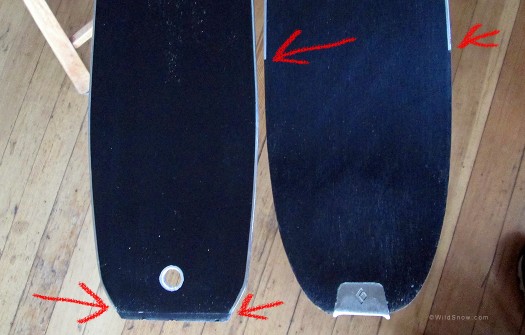Regarding eliminating edges at tip and tail to reduce ski weight, a ski engineer sent over specs for how much ski edges weigh. This especially applies to the new Black Diamond Carbon offerings such as Convert and Aspect, which delete many centimeters of tip and tail edges. (See our weight charts.)

Black Diamond (right) trims quite a bit of weight by eliminating edges at the tip and tail. Sportiva (left) extends their edges farther. I'm in favor of this as a weight saving trick, but consumer testing will determine how much durability is lost. It's perhaps more important to have the edges extending pretty much to the end of the tail (for control when in the backseat on hard snow), while the tip is less important.
According to my source: “…range of edge profiles and stampings out there with significantly different weights. A typical full size alpine ski or snowboard edge (2.0mm high x 2.2mm wide) weighs 53g/m. Thinner edges on some skis in the market (1.3mm high x 1.6mm wide) weigh as little as 27g/m.”
Examples of different edge sizes, measured on skis here at WildSnow HQ after factory finishing (difficult to measure on ski, >< 0.1 mm):
K2 Coomback 2014/15, 1.4 high x 2.0 wide
G3 Synapse Carbon 2014/15, 2.1 high x 2.3 wide
Dynafit Denali 2014/15, 2.2 high, x 1.3 wide
BD Carbon Aspect 2014/15, 1.5 high x 1.3 wide
While it is difficult to know exactly how much the edges on a given brand weigh, for the sake of estimating we can use an average to get an idea how much mass a company such as BD is saving by eliminating edge. Thus, let's say the average edge weight is 40 grams a meter, or .04 grams per millimeter.
That means by eliminating an estimated 88 centimeters of edge from tip/tail of the 180 cm Carbon Convert (I measured), Black Diamond is saving at least 35 grams; more than an ounce per ski. That's noticeable, especially since the weight savings is out on the ends where it makes more of a difference when moving the ski in kick turns and such.
[caption id="attachment_12833" align="aligncenter" width="525" caption="Some of the skis I sampled for edge thickness."] [/caption]
[/caption]
A significant takeaway from this is that skis with full wrap edges could easily weigh 20 grams less per ski by leaving some steel edge off the tips, without the excessive edgeless areas of the Black Diamond skis, especially at the tail. On the other hand, leaving out the edges doesn’t change things much in our charting, as the range of ski weights we cover far exceeds the small differences that edges make. For example, wrapping full tip and tail edges would cause the Convert to score a 71 instead of a 70. Not a huge difference, as the Converts with/without edges would still rank next to each other, between the Goode (lighter) and the G3 Zen C3 (slightly heavier).
All this begs the question, how much do ski edges weigh in total, and how much weight can be saved by using thinner edges? As an example, consider the new G3 Synapse Carbon 101. I measured (rounded to centimeter) 350 centimeters of edge on one 170 centimeter ski.
G3 uses strong thick edges so they’re ultra durable. My theory is that’s necessary because it has something to do with hockey, but I digress. For one Synapse ski the thick G3 edge probably weighs close to the specified 53 grams per meter, or .053 grams per millimeter, for a total edge weight of 185 grams. If the lightest edges are used at the specified .027 grams per millimeter, that’s a total edge weight of 95 grams, resulting in a savings of 90 grams (3 ounces) per ski — significant!
Considering above, I’ll go on the record and say it’s high time for ski companies to make “touring” specific skis that use minimized edge configurations to save considerable weight. For example, say a ski used light edges as well as no edges at tip and tail. Savings from those tweaks alone could be up to 4 ounces or 1/4 pound per ski! Kudos to the companies already experimenting with this.
(It’s worth mentioning that it’s possible to build skis with aluminum edges. While such edges are never as sharp as steel, and most certainly not as durable, they work fine in soft snow. For example, a nordic/alpine ski called the Fischer Expedition had aluminum edges and saw extensive service in the 1970s for big ski traverses and that sort of thing. I used those quite a bit. They worked. Considering this, one has to wonder if a ski company could build a modern AT ski with aluminum edges as the ultimate powder touring machine. Combine that with carbon, and a wide “one kilo” ski would be the result. Perhaps they could even do “hybrid” edges, with steel in a section underfoot and the remainder aluminum.)
WildSnow.com publisher emeritus and founder Lou (Louis Dawson) has a 50+ years career in climbing, backcountry skiing and ski mountaineering. He was the first person in history to ski down all 54 Colorado 14,000-foot peaks, has authored numerous books about about backcountry skiing, and has skied from the summit of Denali in Alaska, North America’s highest mountain.
